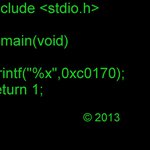mbed library sources
Dependents: Encrypted my_mbed lklk CyaSSL_DTLS_Cellular ... more
Superseded
This library was superseded by mbed-dev - https://os.mbed.com/users/mbed_official/code/mbed-dev/.
Development branch of the mbed library sources. This library is kept in synch with the latest changes from the mbed SDK and it is not guaranteed to work.
If you are looking for a stable and tested release, please import one of the official mbed library releases:
Import librarymbed
The official Mbed 2 C/C++ SDK provides the software platform and libraries to build your applications.
targets/cmsis/TARGET_STM/TARGET_STM32L0/stm32l0xx_hal_tim_ex.c
- Committer:
- mbed_official
- Date:
- 2015-07-01
- Revision:
- 579:53297373a894
- Parent:
- 489:119543c9f674
File content as of revision 579:53297373a894:
/**
******************************************************************************
* @file stm32l0xx_hal_tim_ex.c
* @author MCD Application Team
* @version V1.2.0
* @date 06-February-2015
* @brief TIM HAL module driver.
* @brief This file provides firmware functions to manage the following
* functionalities of the Timer (TIM) peripheral:
* + Time Hall Sensor Interface Initialization
* + Time Hall Sensor Interface Start
* + Time Master and Slave synchronization configuration
@verbatim
================================================================================
##### TIM specific features integration #####
================================================================================
[..] The Timer features include:
(#) 16-bit up, down, up/down auto-reload counter.
(#) 16-bit programmable prescaler allowing dividing (also on the fly) the counter clock
frequency either by any factor between 1 and 65536.
(#) Up to 4 independent channels for:
Input Capture
Output Compare
PWM generation (Edge and Center-aligned Mode)
One-pulse mode output
(#) Synchronization circuit to control the timer with external signals and to interconnect
several timers together.
(#) Supports incremental (quadrature) encoder and hall-sensor circuitry for positioning
purposes
##### How to use this driver #####
================================================================================
[..]
(#) Enable the TIM interface clock using
__HAL_RCC_TIMx_CLK_ENABLE();
(#) TIM pins configuration
(++) Enable the clock for the TIM GPIOs using the following function:
__HAL_RCC_GPIOx_CLK_ENABLE();
(++) Configure these TIM pins in Alternate function mode using HAL_GPIO_Init();
(#) The external Clock can be configured, if needed (the default clock is the internal clock from the APBx),
using the following function:
HAL_TIM_ConfigClockSource, the clock configuration should be done before any start function.
(#) Configure the TIM in the desired operating mode using one of the
configuration function of this driver:
(++) HAL_TIMEx_MasterConfigSynchronization() to configure the peripheral in master mode.
(#) Remap the Timer I/O using HAL_TIMEx_RemapConfig() API.
@endverbatim
******************************************************************************
* @attention
*
* <h2><center>© COPYRIGHT(c) 2015 STMicroelectronics</center></h2>
*
* Redistribution and use in source and binary forms, with or without modification,
* are permitted provided that the following conditions are met:
* 1. Redistributions of source code must retain the above copyright notice,
* this list of conditions and the following disclaimer.
* 2. Redistributions in binary form must reproduce the above copyright notice,
* this list of conditions and the following disclaimer in the documentation
* and/or other materials provided with the distribution.
* 3. Neither the name of STMicroelectronics nor the names of its contributors
* may be used to endorse or promote products derived from this software
* without specific prior written permission.
*
* THIS SOFTWARE IS PROVIDED BY THE COPYRIGHT HOLDERS AND CONTRIBUTORS "AS IS"
* AND ANY EXPRESS OR IMPLIED WARRANTIES, INCLUDING, BUT NOT LIMITED TO, THE
* IMPLIED WARRANTIES OF MERCHANTABILITY AND FITNESS FOR A PARTICULAR PURPOSE ARE
* DISCLAIMED. IN NO EVENT SHALL THE COPYRIGHT HOLDER OR CONTRIBUTORS BE LIABLE
* FOR ANY DIRECT, INDIRECT, INCIDENTAL, SPECIAL, EXEMPLARY, OR CONSEQUENTIAL
* DAMAGES (INCLUDING, BUT NOT LIMITED TO, PROCUREMENT OF SUBSTITUTE GOODS OR
* SERVICES; LOSS OF USE, DATA, OR PROFITS; OR BUSINESS INTERRUPTION) HOWEVER
* CAUSED AND ON ANY THEORY OF LIABILITY, WHETHER IN CONTRACT, STRICT LIABILITY,
* OR TORT (INCLUDING NEGLIGENCE OR OTHERWISE) ARISING IN ANY WAY OUT OF THE USE
* OF THIS SOFTWARE, EVEN IF ADVISED OF THE POSSIBILITY OF SUCH DAMAGE.
*
******************************************************************************
*/
/* Includes ------------------------------------------------------------------*/
#include "stm32l0xx_hal.h"
/** @addtogroup STM32L0xx_HAL_Driver
* @{
*/
/** @addtogroup TIMEx
* @brief TIMEx HAL module driver
* @{
*/
#ifdef HAL_TIM_MODULE_ENABLED
/** @addtogroup TIMEx_Exported_Functions
* @{
*/
/** @addtogroup TIMEx_Exported_Functions_Group1
* @brief Peripheral Control functions
*
@verbatim
===============================================================================
##### Peripheral Control functions #####
===============================================================================
[..] This section provides functions allowing to:
(+) Configure Master and the Slave synchronization.
@endverbatim
* @{
*/
/**
* @brief Configures the TIM in master mode.
* @param htim: TIM handle.
* @param sMasterConfig: pointer to a TIM_MasterConfigTypeDef structure that
* contains the selected trigger output (TRGO) and the Master/Slave
* mode.
* @retval HAL status
*/
HAL_StatusTypeDef HAL_TIMEx_MasterConfigSynchronization(TIM_HandleTypeDef *htim, TIM_MasterConfigTypeDef * sMasterConfig)
{
/* Check the parameters */
assert_param(IS_TIM_MASTER_INSTANCE(htim->Instance));
assert_param(IS_TIM_TRGO_SOURCE(sMasterConfig->MasterOutputTrigger));
assert_param(IS_TIM_MSM_STATE(sMasterConfig->MasterSlaveMode));
__HAL_LOCK(htim);
/* Change the handler state */
htim->State = HAL_TIM_STATE_BUSY;
/* Reset the MMS Bits */
htim->Instance->CR2 &= ~TIM_CR2_MMS;
/* Select the TRGO source */
htim->Instance->CR2 |= sMasterConfig->MasterOutputTrigger;
/* Reset the MSM Bit */
htim->Instance->SMCR &= ~TIM_SMCR_MSM;
/* Set or Reset the MSM Bit */
htim->Instance->SMCR |= sMasterConfig->MasterSlaveMode;
htim->State = HAL_TIM_STATE_READY;
__HAL_UNLOCK(htim);
return HAL_OK;
}
#if defined (STM32L071xx) || defined (STM32L072xx) || defined (STM32L073xx) \
|| defined (STM32L081xx) || defined (STM32L082xx) || defined (STM32L083xx)
/**
* @brief Configures the remapping of the TIM2, TIM3, TIM21 and TIM22 inputs.
* The channel inputs (T1..T4) and the Trigger input (ETR) of the
* timers can be remaped thanks to this function. When an input is
* mapped, on a GPIO, refer yourself to the GPIO alternate functions
* for more details.
* @note It is not possible to connect TIM2 and TIM21 on
* GPIOB5_AF4 at the same time.
* When selecting TIM3_TI2_GPIOB5_AF4, Channel2 of TIM3 will be
* connected to GPIOB5_AF4 and Channel2 of TIM22 will be connected to
* some other GPIOs. (refer to alternate functions for more details)
* When selecting TIM3_TI2_GPIO_DEF, Channel2 of Timer 3 will be
* connected an GPIO (other than GPIOB5_AF4) and Channel2 of TIM22
* will be connected to GPIOB5_AF4.
*
* @param htim: pointer to a TIM_HandleTypeDef structure that contains
* the configuration information for TIM module.
* @param Remap: specifies the TIM input remapping source.
* This parameter is a combination of the following values
* depending on TIM instance:
*
* For TIM2, the parameter can have the following values:
* @arg TIM2_ETR_GPIO: TIM2 ETR connected to GPIO (default):
* GPIOA(0)_AF5 or GPIOA(5)_AF2 or
* GPIOA(15)_AF2 or GPIOE(9)_AF2
* @arg TIM2_ETR_HSI48: TIM2 ETR connected to HSI48
* @arg TIM2_ETR_LSE: TIM2 ETR connected to LSE
* @arg TIM2_ETR_COMP2_OUT: TIM2 ETR connected to COMP2 output
* @arg TIM2_ETR_COMP1_OUT: TIM2 ETR connected to COMP1 output
* @arg TIM2_TI4_GPIO : TIM2 TI4 connected to GPIO1(default):
* GPIOA(3)_AF2 or GPIOB(11)_AF2 or
* GPIOE(12)_AF0
* @arg TIM2_TI4_COMP1: TIM2 TI4 connected to COMP1
* @arg TIM2_TI4_COMP2: TIM2 TI4 connected to COMP2
*
* For TIM3, the parameter can have the following values:
* @arg TIM3_ETR_GPIO: TIM3 ETR connected to GPIO (default):
* GPIOE(2)_AF2 or GPIOD(2)_AF2 or
* GPIOE(2)AF2
* @arg TIM3_ETR_HSI: TIM3 ETR connected to HSI
* @arg TIM3_TI1_USB_SOF: TIM3 TI1 connected to USB_SOF (default)
* @arg TIM3_TI1_GPIO: TIM3 TI1 connected to GPIO :
* GPIOE(3)_AF2 or GPIOA(6)_AF2 or
* GPIOC(6)_AF2 or GPIOB(4)_AF2
* @arg TIM3_TI2_GPIOB5_AF4:TIM3 TI3 connected to GPIOB(5)_AF4
* (refer to note)
* @arg TIM3_TI2_GPIO_DEF: TIM3 TI3 connected to GPIO (default):
* GPIO_A(7)_AF2 or GPIO_B(5)_AF4 or
* GPIOC(7)_AF2 or GPIOE(7)_AF2
* @arg TIM3_TI4_GPIO_DEF: TIM3 TI4 connected to GPIO:
* GPIO_B(1)_AF2 or GPIO_E(6)_AF2
* @arg TIM3_TI4_GPIOC9_AF2:TIM3 TI4 connected to GPIOC(9)_AF2
*
* For TIM21, the parameter can have the following values:
* @arg TIM21_ETR_GPIO: TIM21 ETR connected to GPIO(default) :
* APB2_PC(9)_AF0 or APB2_PA(1)_AF5
* @arg TIM21_ETR_COMP2_OUT:TIM21 ETR connected to COMP2 output
* @arg TIM21_ETR_COMP1_OUT:TIM21 ETR connected to COMP1 output
* @arg TIM21_ETR_LSE: TIM21 ETR connected to LSE
* @arg TIM21_TI1_MCO: TIM21 TI1 connected to MCO
* @arg TIM21_TI1_RTC_WKUT_IT: TIM21 TI1 connected to RTC WAKEUP interrupt
* @arg TIM21_TI1_HSE_RTC: TIM21 TI1 connected to HSE_RTC
* @arg TIM21_TI1_MSI: TIM21 TI1 connected to MSI clock
* @arg TIM21_TI1_LSE: TIM21 TI1 connected to LSE
* @arg TIM21_TI1_LSI: TIM21 TI1 connected to LSI
* @arg TIM21_TI1_COMP1_OUT:TIM21 TI1 connected to COMP1_OUT
* @arg TIM21_TI1_GPIO: TIM21 TI1 connected to GPIO(default):
* GPIOA(2)_AF0 or GPIOB(13)_AF6 or
* GPIOE(5)_AF0 or GPIOD(0)_AF0
* @arg TIM21_TI2_GPIO: TIM21 TI2 connected to GPIO(default):
* GPIOA(3)_AF0 or GPIOB(14)_AF6 or
* GPIOE(6)_AF0 or GPIOD(7)_AF1
* @arg TIM21_TI2_COMP2_OUT:TIM21 TI2 connected to COMP2 output
*
* For TIM22, the parameter can have the following values:
* @arg TIM22_ETR_LSE: TIM22 ETR connected to LSE
* @arg TIM22_ETR_COMP2_OUT:TIM22 ETR connected to COMP2 output
* @arg TIM22_ETR_COMP1_OUT:TIM22 ETR connected to COMP1 output
* @arg TIM22_ETR_GPIO: TIM22 ETR connected to GPIO(default):
* GPIOC(8)_AF0 or GPIOA(4)_AF5
* @arg TIM22_TI1_GPIO1: TIM22 TI1 connected to GPIO(default):
* GPIOC(6)_AF0 or GPIOA(6)_AF5 or
* GPIOB(4)_AF4 or GPIOE(0)_AF3
* @arg TIM22_TI1_COMP2_OUT:TIM22 TI1 connected to COMP2 output
* @arg TIM22_TI1_COMP1_OUT:TIM22 TI1 connected to COMP1 output
* @arg TIM22_TI1_GPIO2: TIM22 TI1 connected to GPIO:
* GPIOC(6)_AF0 or GPIOA(6)_AF5 or
* GPIOB(4)_AF4 or GPIOE(3)_AF0
*
* @retval HAL status
*/
#else
/**
* @brief Configures the remapping of the TIM2, TIM21 and TIM22 inputs.
* The channel inputs (T1..T4) and the Trigger input (ETR) of the
* timers can be remaped thanks to this function. When an input is
* mapped, on a GPIO, refer yourself to the GPIO alternate functions
* for more details.
*
* @param htim: pointer to a TIM_HandleTypeDef structure that contains
* the configuration information for TIM module.
* @param Remap: specifies the TIM input remapping source.
* This parameter is a combination of the following values
* depending on TIM instance:
*
* For TIM2, the parameter can have the following values:
* @arg TIM2_ETR_GPIO: TIM2 ETR connected to GPIO (default):
* GPIOA(0)_AF5 or GPIOA(5)_AF2 or
* GPIOA(15)_AF2 or GPIOE(9)_AF2
* @arg TIM2_ETR_HSI48: TIM2 ETR connected to HSI48
* @arg TIM2_ETR_LSE: TIM2 ETR connected to LSE
* @arg TIM2_ETR_COMP2_OUT: TIM2 ETR connected to COMP2 output
* @arg TIM2_ETR_COMP1_OUT: TIM2 ETR connected to COMP1 output
* @arg TIM2_TI4_GPIO: TIM2 TI4 connected to GPIO1(default):
* GPIOA(3)_AF2 or GPIOB(11)_AF2 or
* GPIOE(12)_AF0
* @arg TIM2_TI4_COMP1: TIM2 TI4 connected to COMP1
* @arg TIM2_TI4_COMP2: TIM2 TI4 connected to COMP2
* @arg TIM2_TI4_GPIO2: TIM2 TI4 connected to GPIO2 :
* GPIOA(3)_AF2 or GPIOB(11)_AF2 or
* GPIOE(12)_AF0
*
* For TIM21, the parameter can have the following values:
* @arg TIM21_ETR_GPIO: TIM21 ETR connected to GPIO(default) :
* APB2_PC(9)_AF0 or APB2_PA(1)_AF5
* @arg TIM21_ETR_COMP2_OUT:TIM21 ETR connected to COMP2 output
* @arg TIM21_ETR_COMP1_OUT:TIM21 ETR connected to COMP1 output
* @arg TIM21_ETR_LSE: TIM21 ETR connected to LSE
* @arg TIM21_TI1_MCO: TIM21 TI1 connected to MCO
* @arg TIM21_TI1_RTC_WKUT_IT: TIM21 TI1 connected to RTC WAKEUP interrupt
* @arg TIM21_TI1_HSE_RTC: TIM21 TI1 connected to HSE_RTC
* @arg TIM21_TI1_MSI: TIM21 TI1 connected to MSI clock
* @arg TIM21_TI1_LSE: TIM21 TI1 connected to LSE
* @arg TIM21_TI1_LSI: TIM21 TI1 connected to LSI
* @arg TIM21_TI1_COMP1_OUT:TIM21 TI1 connected to COMP1_OUT
* @arg TIM21_TI1_GPIO: TIM21 TI1 connected to GPIO(default):
* GPIOA(2)_AF0 or GPIOB(13)_AF6 or
* GPIOE(5)_AF0 or GPIOD(0)_AF0
* @arg TIM21_TI2_GPIO: TIM21 TI2 connected to GPIO(default):
* GPIOA(3)_AF0 or GPIOB(14)_AF6 or
* GPIOE(6)_AF0 or GPIOD(7)_AF1
* @arg TIM21_TI2_COMP2_OUT:TIM21 TI2 connected to COMP2 output
*
* For TIM22, the parameter can have the following values:
* @arg TIM22_ETR_LSE: TIM22 ETR connected to LSE
* @arg TIM22_ETR_COMP2_OUT:TIM22 ETR connected to COMP2 output
* @arg TIM22_ETR_COMP1_OUT:TIM22 ETR connected to COMP1 output
* @arg TIM22_ETR_GPIO: TIM22 ETR connected to GPIO(default):
* GPIOC(8)_AF0 or GPIOA(4)_AF5
* @arg TIM22_TI1_GPIO1: TIM22 TI1 connected to GPIO(default):
* GPIOC(6)_AF0 or GPIOA(6)_AF5 or
* GPIOB(4)_AF4 or GPIOE(0)_AF3
* @arg TIM22_TI1_COMP2_OUT:TIM22 TI1 connected to COMP2 output
* @arg TIM22_TI1_COMP1_OUT:TIM22 TI1 connected to COMP1 output
* @arg TIM22_TI1_GPIO2: TIM22 TI1 connected to GPIO:
* GPIOC(6)_AF0 or GPIOA(6)_AF5 or
* GPIOB(4)_AF4 or GPIOE(3)_AF0
*
* @retval HAL status
*/
#endif /* STM32L07xxx or STM32L08xxx */
HAL_StatusTypeDef HAL_TIMEx_RemapConfig(TIM_HandleTypeDef *htim, uint32_t Remap)
{
__HAL_LOCK(htim);
/* Check parameters */
assert_param(IS_TIM_REMAP(htim->Instance,Remap));
/* Set the Timer remapping configuration */
htim->Instance->OR = Remap;
htim->State = HAL_TIM_STATE_READY;
__HAL_UNLOCK(htim);
return HAL_OK;
}
/**
* @}
*/
/**
* @}
*/
#endif /* HAL_TIM_MODULE_ENABLED */
/**
* @}
*/
/**
* @}
*/
/************************ (C) COPYRIGHT STMicroelectronics *****END OF FILE****/
 mbed official
mbed official





